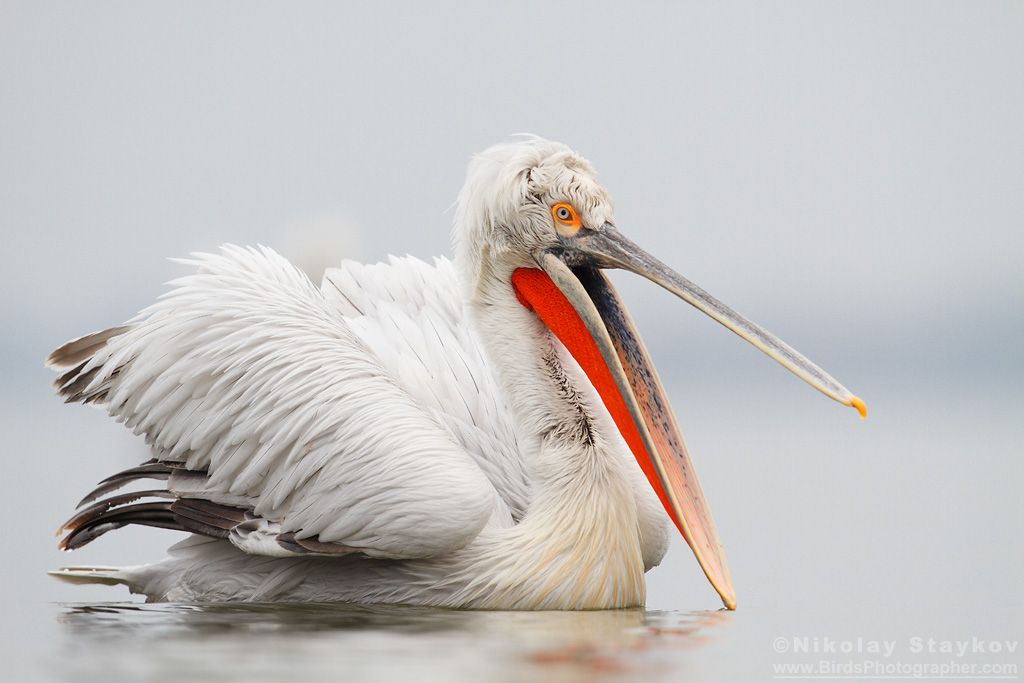Dalmatian pelican
(Pelecanus crispus)

Description
This huge bird is by a slight margin the largest of the pelican species and one of the largest living bird species.It measures 160 to 183 cm (5 ft 3 in to 6 ft 0 in) in length,7.25–15 kg (16.0–33.1 lb) in weight and 245 to 351 cm (8 ft 0 in to 11 ft 6 in) in wingspan Its median weight is around 11.5 kg (25 lb),which makes it perhaps the world's heaviest flying bird species,although the largest individuals among male bustards and swans may be heavier than the largest individual Dalmatian pelican.More recently,six male Dalmatians were found to average 10.4 kg (23 lb) and four females 8.7 kg (19 lb),around the same average weight as the great white pelican (Pelecanus onocrotalus) and slightly lighter than mean body masses from other huge birds such as the trumpeter swan (Cygnus buccinator) or Andean condor (Vultur gryphus).A mean estimated body mass for the Dalmatian pelican of 10.9 kg (24 lb) was also published,around the same mass as the aforementioned largest swan and condor.It is either the heaviest or one of the heaviest birds native to Europe,its closest rivals in mass being mute swans (Cygnus olor) and cinereous vultures (Aegypius monachus),which both weigh on average around 10 kg (22 lb),followed closely by great white pelicans and the whooper swans (Cygnus cygnus).It also appears to have one of the largest wingspans of any living bird,rivaling those of the great albatrosses (Diomedea ssp.,in particular the two largest species,the wandering albatross and southern royal albatross) and the great white pelican.These four species are the only modern birds with verified wingspans that range over 350 cm (11 ft 6 in).The somewhat similar-looking great white pelican broadly overlaps in size but has greater size sexual dimorphism: female great whites can be noticeably smaller than female Dalmatians but male individuals of the two species are essentially the same size and weight However,the Dalmatian differs from this other very large species in that it has curly nape feathers,grey legs and silvery-white (rather than pure white) plumage.In winter,adult Dalmatian pelicans go from silvery-grey to a dingier brownish-grey cream colour Immature birds are grey and lack the pink facial patch of immature white pelicans.The loose feathers around the forehead of the Dalmatian pelican can form a W-like-shape on the face right above the bill.n the breeding season it has an orange-red lower mandible and pouch against a yellow upper mandible.In winter,the whole bill is a somewhat dull yellow.The bill,at 36 to 45 cm (14 to 18 in) long,is the second largest of any bird,after the Australian pelican (Pelecanus conspicillatus).The bare skin around the eye can vary from yellow to purplish in colour Among standard measurements,compared to the great white pelican,the Dalmatian's tarsus is slightly shorter,at 11.6 to 12.2 cm (4.6 to 4.8 in),but its tail and wing chord length are notably larger,at 22 to 24 cm (8.7 to 9.4 in) long and 68 to 80 cm (27 to 31 in),respectively.When the Dalmatian pelican is in flight,unlike other pelicans,its wings are solid grayish-white with black tips.It is an elegant soaring bird.When a whole flock of Dalmatian pelicans is in flight,all its members move in graceful synchrony,their necks held back like a heron's.The Dalmatian pelican is often silent,as most pelicans tend to be,although it can be fairly vocal during the mating season,when it may engage in a wide range of guttural,deep vocalisations,including barks,hisses and grunts
Taxonomic tree:







